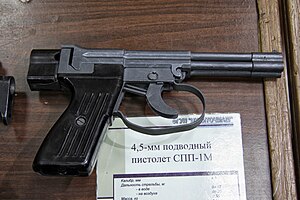SPP-1 underwater pistol
| SPP-1 | |
|---|---|
 SPP-1M | |
| Type | Underwater pistol |
| Place of origin | Soviet Union |
| Service history | |
| In service | 1975–present |
| Used by | Russia |
| Production history | |
| Designer | Vladimir Simonov[1] at TsNIITochMash[2] - ЦНИИТочмаш (Central Scientific Institute for Precision Machine Building) |
| Designed | 1960s (Late) |
| Manufacturer | TOZ (Tulsky Oruzheiny Zavod) (Тульский Оружейный Завод) Tula Arms Plant[3] |
| Produced | 1971–present[4] |
| Variants | SPP-1M[2] |
| Specifications | |
| Mass | 950 grams (34 oz) empty,[2][5] 1,030 grams (36 oz) loaded[6] |
| Length | 244 millimetres (9.6 in)[2][5] |
| Width | 37 millimetres (1.5 in)[5] |
| Height | 136 millimetres (5.4 in)[5] |
| Cartridge | 4.5×40mmR[7] |
| Caliber | 4.5 millimetres (0.18 in)[2] |
| Action | double action[2] |
| Muzzle velocity | 240 to 250 metres per second (790 to 820 ft/s) in air[7] |
| Effective firing range | in air, 15 to 20 metres (49 to 66 ft);[2] in water,[5] |
| Feed system | 4 barrels with a cartridge in each[2] |
The SPP-1 underwater pistol was made in the Soviet Union for use by Soviet frogmen as an underwater firearm.[2] It was developed in the late 1960s and accepted for use in 1975.[8] Under water, ordinary-shaped bullets are inaccurate and very short-range. As a result, this pistol fires a round-based 4.5 millimetres (0.18 in) caliber steel dart about 115 millimetres (4.5 in) long, weighing 12.8 grams (0.45 oz), which has longer range and more penetrating power than speargun spears. The complete cartridge is 145 millimetres (5.7 in) long and weighs 17.5 grams (0.62 oz).[7]
Design
The SPP-1 has four barrels, each containing one cartridge. Its ammunition comes as a magazine of four cartridges which is inserted into the pistol's breech.[6]
Its barrel is not rifled; the fired projectile is kept in line by hydrodynamic effects. As a result, it is somewhat inaccurate when fired out of water.[1]
A double-action firing mechanism fires one cartridge sequentially for each pull of the trigger. When all four cartridges are spent, the gun can be reloaded above or below water.[2]
The SPP-1M pistol is essentially the same as the SPP-1, with the following differences:[6]
- It has an extra spring above the sear to improve the trigger pull.
- Its trigger guard is larger to accommodate diving gloves.
The weapon was designed by Vladimir Simonov, the cartridge by Pyotr Sazonov and Oleg Kravchenko.[1] Simonov also designed the APS amphibious rifle.[9]
Performance
Depth reduces range because the higher pressure closes the cavity sooner. Once the projectile is no longer supercavitating, hydrodynamic drag increases greatly, and the projectile becomes unstable.
Lethal range is defined as the range from which it can easily penetrate a padded underwater suit or a 5 millimetres (0.20 in) thick glass faceplate.[5]
It is manufactured by TOZ (Tulsky Oruzheiny Zavod/ Тульский Оружейный Завод) Tula Arms Plant,[3] and exported by Rosoboronexport,[2] the state agency for Russia's export and import of defense-related products.
Users
 Georgia -In limited use with special operations forces.[citation needed]
Georgia -In limited use with special operations forces.[citation needed] Kazakhstan[10]
Kazakhstan[10] Russia
Russia Soviet Union
Soviet Union Ukraine
Ukraine Serbia
Serbia
Variants
The SPP-1M has been copied by Iran.[11]
See also
References
- Notes
- ^ a b c ”Firearms Technical Trivia ”, cruffler.com, November 2001, Retrieved 2010-04-05
- ^ a b c d e f g h i j k Popenker, Max R. "SPP-1 underwater pistol Archived 2004-12-09 at the Wayback Machine", world.guns.ru, Retrieved 2010-04-05
- ^ a b “Special Submarine Pistol SPP-1M Archived 2010-01-29 at the Wayback Machine”, Tulsky Oruzheiny Zavod(TOZ), Tula Arms Plant, Retrieved 2010-04-05
- ^ "ЦАМТО / / Ростех завершил поставки подводного оружия инозаказчику".
- ^ a b c d e f “4.5-mm SPP-1M Underwater Pistol Archived 2008-06-17 at the Wayback Machine”, TsNIITochMash, Retrieved 2010-04-05
- ^ a b c “SPP-1 and SPP-1M underwater pistol 4.5mm ”, www.securityarms.com, Retrieved 2010-04-05
- ^ a b c “4.5-mm SPS underwater fire cartridge Archived 2008-06-17 at the Wayback Machine”, Tsniitochmash, Retrieved 2010-04-05
- ^ "Russia upgrades amphibious rifles for commando swimmers | weapons defence industry military technology UK | analysis focus army defence military industry army". 24 January 2020.
- ^ Popenker, Max R. "APS underwater assault rifle (5.6x39 mm MPS) Archived 2004-10-25 at the Wayback Machine", world.guns.ru, Retrieved 2010-04-05
- ^ Small Arms Survey (2012). "Blue Skies and Dark Clouds: Kazakhstan and Small Arms". Small Arms Survey 2012: Moving Targets. Cambridge University Press. p. 133. ISBN 978-0-521-19714-4. Archived from the original (PDF) on August 30, 2012.
- ^ Sutton, HI. "Iran Copies' Russian SPP-1M Underwater Pistol". www.hisutton.com. HI Sutton. Retrieved 8 June 2021.
- Sources
- Cutshaw, Charlie, “The New World of Russian Small Arms & Ammo”, 1998, (Paladin Press, Boulder, Colorado) ISBN 0-87364-993-1
External links

- Picture and information
- Technical specification
- Description, image of firearm and darts, and specifications
- Image of firearm, breech opened, and specifications
- v
- t
- e
| Survival guns | |
|---|---|
| Multi-weapons | |
| Rotary type | |
|---|---|
- Flash-ball
- Osa
- Heckler & Koch P11
- Mk1 UDG
- SPP-1 underwater pistol






















